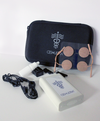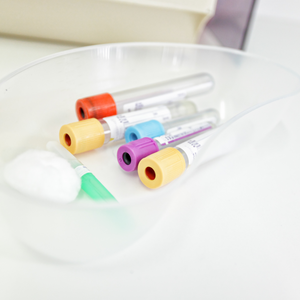Cranial Electrotherapy Stimulation
Sulcata Psychiatry offers multiple alternative treatment therapy options that are non-pharmacological based. The CES Ultra is an alternative treatment option that can be used alone or in conjunction with medication management for relief of anxiety, mood, and insomnia symptoms. We offer both purchase and rental options at our main office in Tomball, Texas.

What is CES (Cranial Electrotherapy Stimulation)?
Cranial Electrotherapy Stimulation (CES) is a term the FDA uses to describe low grade electrical stimulation for treatment of anxiety and insomnia. The majority of these devices deliver electrical stimulation via the Auricular branch of the Vagus nerve, meaning the electrodes are applied to the ear to target the nervous system, leading to the term Auricular Neurostimulation.
Research on CES has been ongoing since the 1950's, originally targeting sleep disorders. Over time, further studies have led to better understanding between brain function, neurotransmitters, and electrical activity that assists in the regulation of neurochemical release. By indirectly stimulating specific areas of the nervous system with electricity, we can effect the release of neurotransmitters in the brain. This is particularly helpful when chemical and electrical activity has been destabilized by situational or biological dysregulation.
Research on Auricular Neurostimulation has shown improvements in memory and cognition, altered neuronal firing and brain wave patterns as measured by EEG, increased parasympathetic activity (rest & digest) as opposed to sympathetic activity (fight or flight), synchronicity and homeostasis of multi-organ systems, as well as enhanced uptake and absorption of oral medications when used within 30 minutes of taking medication. It also is theorized that Auricular Neurostimulation may increase neurogenesis and neuroplasticity and reduce inflammation.
What is CES Ultra?
The CES Ultra is an FDA cleared medical device that uses low frequency electrical impulses to stimulate the auricular branch of the Vagus nerve bilaterally. The device is non-invasive, portable, and simple to use.
The CES Ultra is indicated by the FDA for improving symptoms of anxiety disorders and insomnia. However, there are other areas of research that show Auricular Neurostimulation can improve symptoms of depression, gastrointestinal disorders such as IBS, chronic pain, fibromyalgia, addiction and withdrawal, ADHD, panic attacks, headaches, and phobias.
Is CES Ultra Safe?
There are no known contraindications to using the CES Ultra device. However, the device has not been studied in patients who are epileptic, pregnant, or have implanted electronic devices such as cardiac pacemakers or cochlear implants. While the low frequency electrical stimulation that the device emits does not create risk for electrocution, caution should be used in these populations to determine appropriateness for treatment using the CES Ultra.
What are the side effects of CES Ultra?
The CES Ultra device has no known major side effects. While tingling is commonly experienced during and for a short time after treatment, pain or irritation of ear lobes is rare and can be eliminated by turning down the stimulation intensity upon next use. About 3% of patients report a mild brief headache with initial use, which can also be eliminated by reducing the stimulation intensity upon next use.
Some patients have an initial feeling of ecstasy or calm within the first several minutes of treatment. While this side effect is not reported as bothersome, it does tend to reduce in intensity with continued use. However, this does not mean that the device is not working, but that your nervous system is adapting to the stimulation in the way it is supposed to.
When used for insomnia, some patients experience initial intense or vivid dreams as the device begins to result in increased REM sleep. The dreams are not generally reported to be disturbing and tend to diminish as sleep cycles regulate with continued use.
Some patients notice an increase in energy levels when using CES Ultra. While this is beneficial for the majority of patients, if you are using the device for insomnia, it is recommended that treatments be done in early morning or afternoon to prevent restlessness at night.
How do I use the CES Ultra?
There are several protocols available for using the CES Ultra. Sulcata Psychiatry's standard protocol involves wearing the device for 30 minutes per day in the morning and in the afternoon, at least 1 hour prior to bed time. To use, simply apply saline solution to ear clips, attach clips to both ears, and twist the knob to turn on and adjust intensity.
Most patients see mild to moderate benefits in regards to their targeted symptoms within 3-5 days of continued use and significant improvements around 2 weeks using the standard protocol. By 1 month of continued daily use, targeted symptoms should be minimal and responding with noticeable benefit. It is important to do treatments consistently over the first month, as the effects are cumulative and will continue to progress with continued use.
There are no time restrictions to length of continued treatments nor any long-term risks associated with prolonged use of the CES Ultra. Our recommendation is to continue treatments for a minimum of 2 months. However, if symptoms have improved after a month, many patients reduce frequency to 5 days per week or move to the as-needed protocol. Other patients love the device and continue to do treatments indefinitely to prevent future recurrence, which is especially the case in more chronic conditions such as fibromyalgia. This is a personal choice based on preference and the longevity of symptom relief you experience.
How do I access the CES Ultra?
We offer both purchase options as well as monthly rentals of the CES Ultra device. Current pricing for purchase of the CES Ultra device is set at $300. Monthly rentals are available to try the device out prior to purchase or for shorter term use at $100 per month. Please contact the office for rental and purchase availability and details.
For more information on the CES Ultra and the science behind it's development, click HERE.
















